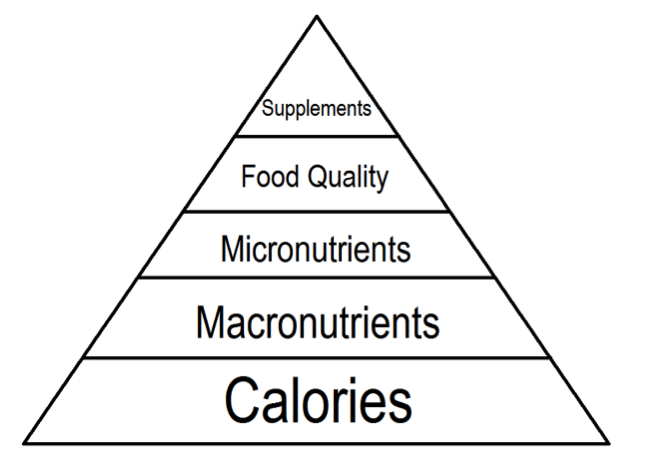How to Construct your Diet Part 1: Health vs. Body Composition and Introducing the REAL Food Pyramid
By: Ari Snaevarsson, Staff Writer
As was mentioned in the meal plans section, I have so far played the role of the teacher who answers your question with an analogy, not an actual answer. What follows is the actual answer. I do apologize for how absurdly long it has taken to get here, but, as someone who believes strongly in the value of brevity, I can assure you it was all important material. If you have yet to read the first part, that will not prevent you from understanding what is discussed here, but you are missing out on some vital information.
Quickly, I want to clarify something I could see being slightly confounding. Eating healthy and eating to change one’s body composition are two totally different concepts. Consider the first part of this series (every article prior to this one) mainly focused on healthy eating; habits that allow your body to more efficiently fight off diseases, metabolize nutrients, deal with physical or mental distress, reproduce, get rid of waste, etc.
This next part of the series, on how to construct your diet, will now shift focus towards the latter concept. Eating to change one’s body composition means manipulating intake of nutrients to induce weight gain or weight loss. I have also mentioned eating to increase strength or athleticism; while this is technically not the same thing as changing body composition, it is a change in efficacy of bodily mechanisms and structures and, as such, will be included in this section.
The reason I so far have used the terms almost interchangeably is that I view them as a one-two punch. Changing one’s body composition for the better will vastly improve health parameters, while eating a healthier diet can undoubtedly aid in losing/gaining weight or getting stronger/faster.
Dietary advice seems to always come off, likely due to its inherent complexity, as high-flown and elitist. There is so much information out there that the roadblock in most people’s fitness journeys occurs right at the get-go; where do you even begin with this?
For that reason, I repeatedly refer people to a concept, which I do not claim credit for, called hierarchical nutrition. This concept was created, or at least popularized, by natural bodybuilding coach and scientist Eric Helms. The beauty of it, in my opinion, is that it allows us to effectively compartmentalize nutrition and prioritize certain elements.
Below is a simple pyramid I put together that explains this concept (note: although I drew this one, the idea of the pyramid is also the product of Helms). As we move from bottom to top, the importance of each category gradually decreases. So, from this, we can ascertain that the aspect of utmost importance is going to be caloric balance. As was alluded to in the first part, by taking in more calories than our body expends in a day, we can elicit weight gain. Similarly, taking in fewer calories than we expend will lead to weight loss.
Next, we have macronutrients; the nutrients from where we get these calories. Macronutrient manipulation means deciding how many grams of protein, carbohydrates, and fats (arguably, fiber as well) we consume each day to reach our caloric goals. A gram of carbohydrates contains 4 calories; a gram of protein contains 4 as well; and a gram of fat contains 9 calories. Alcohol, while not a macronutrient, contains 7 calories per gram.
After macronutrients comes micronutrients; these are vitamins and minerals, nutrients that are counted in milligrams, rather than grams. If we were concerned solely with health, I would probably have macronutrients and micronutrients switch places. That said, their performance benefits speak for themselves, and it is rather difficult for a body ridden with vitamin/mineral deficiencies to engage in any sort of exercise optimally.
The placement of food quality and supplements will come as a shock to most people, as pervasive old school mantras and beliefs would have you think you can lose weight and get in shape by eating organic, non-GMO “superfoods” and popping whatever miracle pill is hot and trendy now. Why they would have you believe foods containing words you cannot pronounce are bad, but pills containing herbs you have never heard of are good is a question I encourage you to bring up with them, because I have not the slightest idea. Regardless, these two elements do play a role in the context of a proper diet and, as such, warrant at least some discussion.
The next article will start us off talking about the first and most crucial stage of this pyramid, calories, so stay tuned.

